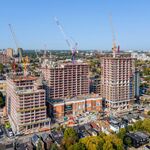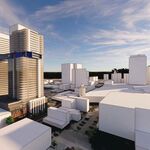M II A II R II K
Senior Member
If those LRTs end up stopping at red lights in between and end up slowing it down for whatever reason then they fucked it up. Especially when it could have been given proper priority.
Do you trust the TTC to do it properly?
Obviously it's an insurmountable problem so we should flush $8 billion to grade separate everything as the logical next step.
I think there's a general consensus (except the Fords maybe) that elevated should be the best choice east of Laird, underground at Don Mills and Kennedy.
I would prefer they spend the extra $$$ on elevated then hve the TTC run an LRt at grade in the middle of the road. I don't trust the TTC to operate an median ROW LRT at grade. There I said it.
If those LRTs end up stopping at red lights in between and end up slowing it down for whatever reason then they fucked it up. Especially when it could have been given proper priority.
I agree. I see no problem building short distance subways. People would expect Eglinton LRT would be running like the subway lines which during rushhour is a few minutes and non-rush hour not that much longer. I know thats what I was expecting but I read somewhere on UT that Metrolinx had said it would run 12 min during rushour and 20 min non-rush. This will be a major problem and not acceptable. You build a tunnel portion and it runs like surface transit.Somehow I don't see a properly done light rail possible for EC. The tunneled portion could be a breeze to travel through then face gridlock in the at-grade sections. As such periods of several minutes could transpire with no surface, causing crowding at stops then all of a sudden two, three vehicles appear at once. This isn't better than buses but more encouragement to take private modes of transport. I'd prefer short-distance subways that intensify stops where necessary than line after line of kilometre-apart ones that require monster suburban terminals to feed them with multiple bus routes. EC as a LRT line wouldn't be faster than the buses its replacing, which is why we should support an Eglinton subway line instead.
I do not sense a consensus in reading these posts. I think many people think at-grade is preferable to elevated even if there were no cost difference. If is even preferable to underground since you can see the street. Maybe it is just ideology to oppose anything from Ford.
If there were a consensus, or even a thought that elevated was nearly as good as at-grade, someone would have done a better job costing to see what exactly (the estimated) cost difference is. What I find surprising is not that Ford, a novice in the field of transit, does not consider elevated rail, but that no one at the TTC or Metrolinx offered this as an affordable compromise. I have yet to hear Ford say he would not accept an elevated line.
the line could be automated. That is a big money saver
Seattle may provide a good comparison - it''s LRT is "metro-like" on generally exclusive RoW (elevated) with only one section at grade - down the middle of Martin Luther King Jr. Blvd. (discounting the downtown tunnel that is shared with buses).
I'd be curious as to what the actual savings would be for automation. I would think that the labour costs of a few drivers are a relatively small proportion of the cost of a line, relative to station attendants, cleaners, maintenance, etc. etc. etc.
I think the real benefit of full grade separation is, as you noted, higher speed and capacity (which in turn presumably means higher ridership and thus higher revenue).
I do not sense a consensus in reading these posts. I think many people think at-grade is preferable to elevated even if there were no cost difference. If is even preferable to underground since you can see the street. Maybe it is just ideology to oppose anything from Ford.
If there were a consensus, or even a thought that elevated was nearly as good as at-grade, someone would have done a better job costing to see what exactly (the estimated) cost difference is. What I find surprising is not that Ford, a novice in the field of transit, does not consider elevated rail, but that no one at the TTC or Metrolinx offered this as an affordable compromise. I have yet to hear Ford say he would not accept an elevated line.
I think the TTC has really dropped the ball on considering all options. In fact, they go out of their way NOT to consider all options (especially looking at some recent EAs).
The TTC itself is to blame for not building more subways, by insisting any subway anywhere must always have gigantic stations and underground 100% of the time with no eye to cost-cutting by elevating or running at-grade where appropriate. Both Bloor-Danforth and Yonge-University-Spadina have at-grade or elevated sections. Yet as many have pointed out, we have the subway running to Vaughan Centre completely underground. How insane is that? At the very least they could have trenched it and buried it when the need was there.
I see no reason our HRT must be buried all the time, especially on the fringes. HRT CAN and HAS been run that way even here yet the possibility is dismissed out of hand, and that's why we're paying $300 million/km of subway these days.
On the flip side, the idea of running our LRTs in the median is slightly ridiculous when you have a perfectly good ROW right beside the street. Having an LRT stop at traffic lights won't result in significant speed increases over buses, so what is the point?
To be fair, the Eglinton LRT is well-designed from the underground perspective and from the stop spacing perspective, but I feel much more could be done to make the at-grade portions faster.




